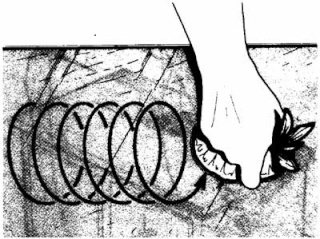Shellac is the easiest of the classic finishes to apply. It produces a very fine, mellow finish, and it accentuates the natural grain of the wood. It is especially attractive on walnut, mahogany, and fine veneer woods. It polishes well and is the basis for the traditional French polish finish on very fine furniture.
Shellac is applied in several thin coats. It dries fast and can be recoated after four hours. Application mistakes can occur since many coats are required, but they are easy to fix.
The big drawback to shellac is that it is not durable. Shellac is easily damaged and dissolves in both water and alcohol. White rings are usually a problem. Shellac cannot be applied in very humid weather because humidity turns it white. Shellac finishes absorb moisture and sometimes turn hazy or white with age. Repairs are easy, but frequent retouching is necessary.
Shellac tends to be soft after it dries, so waxing is almost essential to protect the surface. It is best used on decorative pieces that don't have to stand up to hard wear. Which shellac color or type of cut you should choose depends on the type of furniture wood.
Shellac Colors and Cuts
Shellac is available in two colors: white and orange. White shellac is used for light woods and is thinned with denatured alcohol for use as a sealer. It can be tinted with alcohol-soluble aniline dye and is sometimes available in colors. Orange shellac gives an amber color to the wood; this is often desirable on dark woods. It is especially attractive on walnut, mahogany, and teak.
Shellac is sold in several cuts, or concentrations. The most common type is a 4-pound cut. Shellac must usually be thinned or cut with denatured alcohol before application, as directed by the manufacturer. For sealer, thin 1 part of 3- or 4-pound-cut white shellac with 4 parts denatured alcohol. For finish coats, thin 1 part 4-pound shellac with 2 parts alcohol.
Special Requirements
Shellac can be used over any stain except alcohol-base types and over any filler. Thinned shellac is recommended for sealer coats. Use denatured alcohol to thin shellac; use alcohol or ammonia for cleanup. Shellac has a very short shelf life; old shellac does not dry properly. Buy just enough for the job, and junk any leftover shellac. Some manufacturers even shelf-date shellac.
Basic Application Techniques
Wood to be finished with shellac must be properly prepared, sanded, and sealed. Immediately before applying shellac, clean each surface thoroughly with a tack cloth. Use a new, clean, good-quality brush, and use only new shellac, thinned to a 1-pound cut. Work on one area at a time.
To apply shellac, flow it liberally onto the surface, working in long, smooth strokes along the grain of the wood. Keep the surface really wet with the shellac, and apply the finish from dry to wet edges. After coating the surface completely, tip off the shellac along the grain of the wood. Use an almost dry brush for this step. Holding the brush at a slight angle to the surface, very lightly stroke the surface of the shellac to remove brush marks and even the surface. Smooth the entire shellacked surface, working in strips along the grain of the wood.
The French Polish Finish Technique
This shellac finishing technique produces a much more durable surface than the standard shellac finish. French-polished surfaces have a very distinctive, velvety sheen, and the grain and color of the wood are emphasized. It is best used on close-grained woods and fine veneers. Use only water stain or spirit-base non-grain-raising (NGR) stain under French polish; other types may bleed or lift.
To apply a French polish finish, mix 2 tablespoons of boiled linseed oil into 1 pint of 1-pound-cut shellac. Make a palm-size pad of cheesecloth, and wrap it in a clean, lint-free linen or cotton cloth. The pad should just fit in your palm. Dip the pad into the shellac/oil mixture; don't soak it. Make sure the surface of the pad is not wrinkled.
Apply the shellac/oil mixture to the prepared wood, spreading it evenly along the grain to cover the entire surface; work with a quick padding stroke, blending your strokes carefully. Then rub the wet surface with the pad, using a firm circular or figure-eight motion over the wood. Continue this circular rubbing for about 45 minutes, using plenty of downward pressure and adding shellac as the mixture is worked into the wood. The surface should be evenly glossy, with no dark spots or stroke marks.
Let the rubbed shellac/oil mixture dry for 24 hours; then apply another coat of shellac/oil as above. Rub the second coat in for 45 minutes, and let it dry for two to three days. Apply a third coat the same way.
Let the wood dry for at least a week, but not more than 10 days, after the final coat. Finally, clean the surface, wax the finished wood with a good-quality paste wax, and buff it to a fine sheen.

The French Polish Finish is achieved by hand-rubbing. Apply the shellac/oil mixture
and rub it in with a circular or figure-eight motion. Continue rubbing
for 45 minutes, adding more finish as necessary
Drying and Recoating
Shellac dries in about 30 minutes and can be recoated after four hours. Let the new shellac set for a full four hours. Make sure drying time is adequate. Shellac is soft, and it can pick up sandpaper grains or steel wool shreds if it isn't completely dry. This can result in a nightmare of smoothing to remove the debris.
When the shellac is completely dry, lightly sand the surface with grade 7/0 open-coat sandpaper on a padded sanding block. Clean the sanded surface thoroughly with a tack cloth, then apply a second coat of shellac, as above. Let the shellac dry for four hours; repeat, sanding and cleaning the surface, to apply a third coat. Additional coats of shellac can be added, if you want a smoother surface; let each coat dry thoroughly before applying a new one, and buff the finish with fine steel wool between coats.
Let the final coat of shellac harden for 48 hours. With grade No. 0000 steel wool, remove the gloss from the finished surface, rubbing carefully along the grain of the wood. Do not rub across the grain. When the gloss is completely removed, let the piece of furniture stand for 48 hours. Then apply a good-quality paste wax to the finished wood, and buff the surface to a shine with a soft cloth or the buffing attachment of an electric drill.
Another option to consider is a lacquer finish, which dries quickly but can be difficult to apply depending on the job. Learn when and how to lacquer furniture in the next section.
Shellac is applied in several thin coats. It dries fast and can be recoated after four hours. Application mistakes can occur since many coats are required, but they are easy to fix.
The big drawback to shellac is that it is not durable. Shellac is easily damaged and dissolves in both water and alcohol. White rings are usually a problem. Shellac cannot be applied in very humid weather because humidity turns it white. Shellac finishes absorb moisture and sometimes turn hazy or white with age. Repairs are easy, but frequent retouching is necessary.
Shellac tends to be soft after it dries, so waxing is almost essential to protect the surface. It is best used on decorative pieces that don't have to stand up to hard wear. Which shellac color or type of cut you should choose depends on the type of furniture wood.
Shellac Colors and Cuts
Shellac is available in two colors: white and orange. White shellac is used for light woods and is thinned with denatured alcohol for use as a sealer. It can be tinted with alcohol-soluble aniline dye and is sometimes available in colors. Orange shellac gives an amber color to the wood; this is often desirable on dark woods. It is especially attractive on walnut, mahogany, and teak.
Shellac is sold in several cuts, or concentrations. The most common type is a 4-pound cut. Shellac must usually be thinned or cut with denatured alcohol before application, as directed by the manufacturer. For sealer, thin 1 part of 3- or 4-pound-cut white shellac with 4 parts denatured alcohol. For finish coats, thin 1 part 4-pound shellac with 2 parts alcohol.
Shellac Thinning Proportions for 4-pound Base
Cut.................................Shellac.........................Alcohol
1/2 pound.........................1 part.........................5 parts
1 pound............................1 part.........................2 parts
2 pound............................4 parts........................3 parts
21/2 pound........................2 parts.........................1 part
3 pound............................4 parts...........................1 part
Cut.................................Shellac.........................Alcohol
1/2 pound.........................1 part.........................5 parts
1 pound............................1 part.........................2 parts
2 pound............................4 parts........................3 parts
21/2 pound........................2 parts.........................1 part
3 pound............................4 parts...........................1 part
Special Requirements
Shellac can be used over any stain except alcohol-base types and over any filler. Thinned shellac is recommended for sealer coats. Use denatured alcohol to thin shellac; use alcohol or ammonia for cleanup. Shellac has a very short shelf life; old shellac does not dry properly. Buy just enough for the job, and junk any leftover shellac. Some manufacturers even shelf-date shellac.
Basic Application Techniques
Wood to be finished with shellac must be properly prepared, sanded, and sealed. Immediately before applying shellac, clean each surface thoroughly with a tack cloth. Use a new, clean, good-quality brush, and use only new shellac, thinned to a 1-pound cut. Work on one area at a time.
To apply shellac, flow it liberally onto the surface, working in long, smooth strokes along the grain of the wood. Keep the surface really wet with the shellac, and apply the finish from dry to wet edges. After coating the surface completely, tip off the shellac along the grain of the wood. Use an almost dry brush for this step. Holding the brush at a slight angle to the surface, very lightly stroke the surface of the shellac to remove brush marks and even the surface. Smooth the entire shellacked surface, working in strips along the grain of the wood.
The French Polish Finish Technique
This shellac finishing technique produces a much more durable surface than the standard shellac finish. French-polished surfaces have a very distinctive, velvety sheen, and the grain and color of the wood are emphasized. It is best used on close-grained woods and fine veneers. Use only water stain or spirit-base non-grain-raising (NGR) stain under French polish; other types may bleed or lift.
To apply a French polish finish, mix 2 tablespoons of boiled linseed oil into 1 pint of 1-pound-cut shellac. Make a palm-size pad of cheesecloth, and wrap it in a clean, lint-free linen or cotton cloth. The pad should just fit in your palm. Dip the pad into the shellac/oil mixture; don't soak it. Make sure the surface of the pad is not wrinkled.
Apply the shellac/oil mixture to the prepared wood, spreading it evenly along the grain to cover the entire surface; work with a quick padding stroke, blending your strokes carefully. Then rub the wet surface with the pad, using a firm circular or figure-eight motion over the wood. Continue this circular rubbing for about 45 minutes, using plenty of downward pressure and adding shellac as the mixture is worked into the wood. The surface should be evenly glossy, with no dark spots or stroke marks.
Let the rubbed shellac/oil mixture dry for 24 hours; then apply another coat of shellac/oil as above. Rub the second coat in for 45 minutes, and let it dry for two to three days. Apply a third coat the same way.
Let the wood dry for at least a week, but not more than 10 days, after the final coat. Finally, clean the surface, wax the finished wood with a good-quality paste wax, and buff it to a fine sheen.

The French Polish Finish is achieved by hand-rubbing. Apply the shellac/oil mixture
and rub it in with a circular or figure-eight motion. Continue rubbing
for 45 minutes, adding more finish as necessary
Drying and Recoating
Shellac dries in about 30 minutes and can be recoated after four hours. Let the new shellac set for a full four hours. Make sure drying time is adequate. Shellac is soft, and it can pick up sandpaper grains or steel wool shreds if it isn't completely dry. This can result in a nightmare of smoothing to remove the debris.
When the shellac is completely dry, lightly sand the surface with grade 7/0 open-coat sandpaper on a padded sanding block. Clean the sanded surface thoroughly with a tack cloth, then apply a second coat of shellac, as above. Let the shellac dry for four hours; repeat, sanding and cleaning the surface, to apply a third coat. Additional coats of shellac can be added, if you want a smoother surface; let each coat dry thoroughly before applying a new one, and buff the finish with fine steel wool between coats.
Let the final coat of shellac harden for 48 hours. With grade No. 0000 steel wool, remove the gloss from the finished surface, rubbing carefully along the grain of the wood. Do not rub across the grain. When the gloss is completely removed, let the piece of furniture stand for 48 hours. Then apply a good-quality paste wax to the finished wood, and buff the surface to a shine with a soft cloth or the buffing attachment of an electric drill.
Another option to consider is a lacquer finish, which dries quickly but can be difficult to apply depending on the job. Learn when and how to lacquer furniture in the next section.

 Latest images
Latest images



 Wed Feb 04, 2015 4:02 pm by Ken Schwendinger
Wed Feb 04, 2015 4:02 pm by Ken Schwendinger